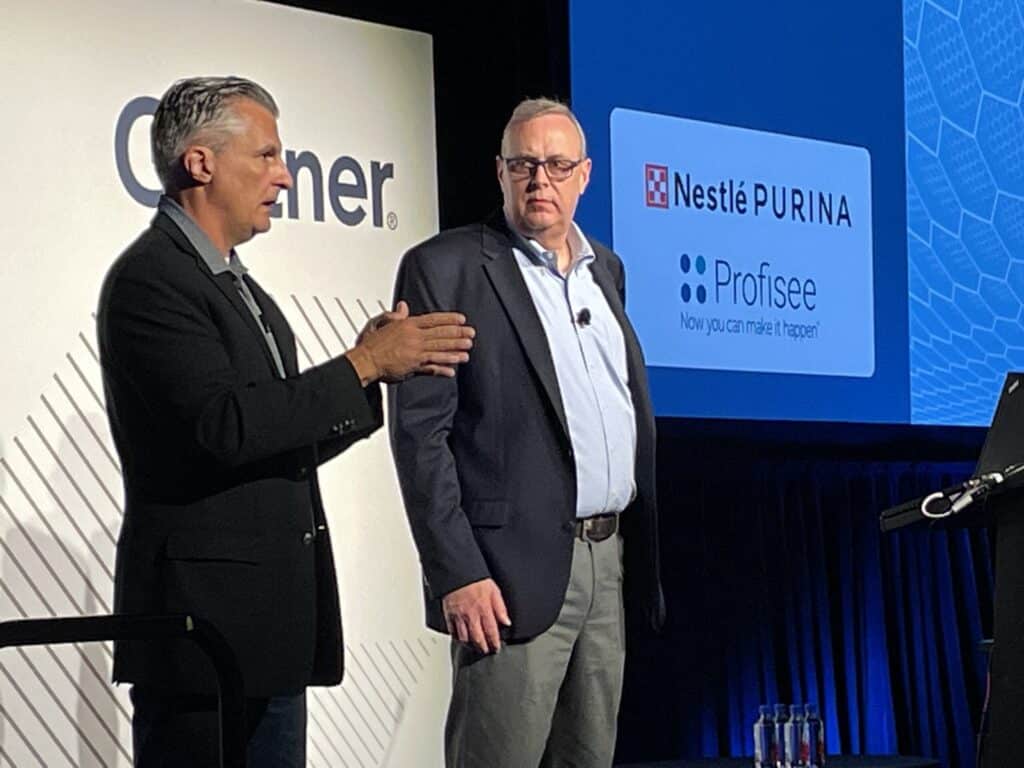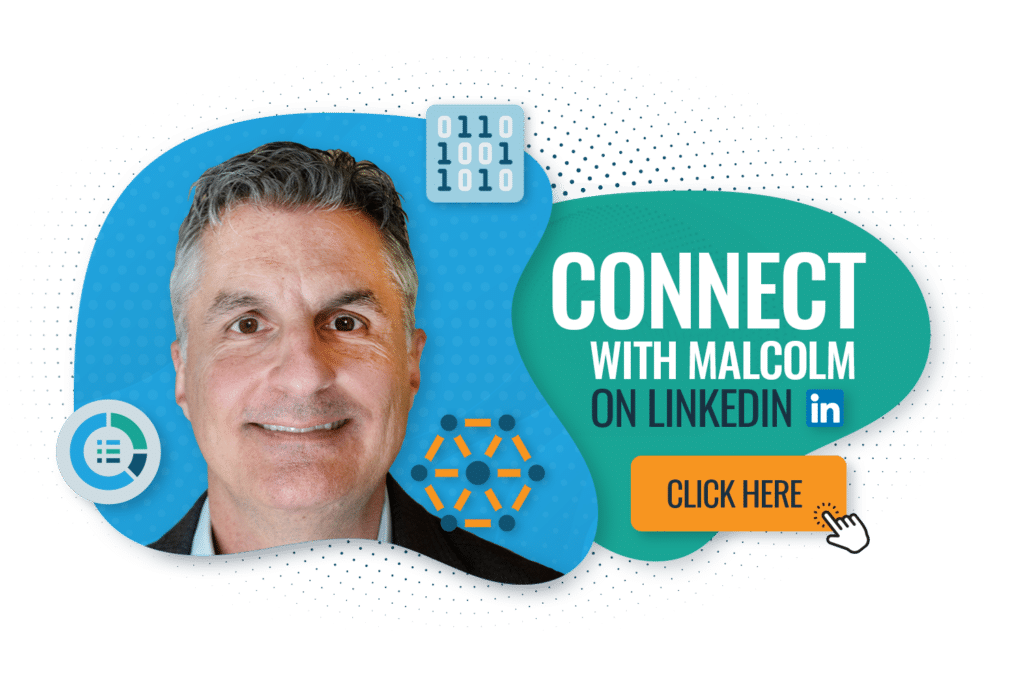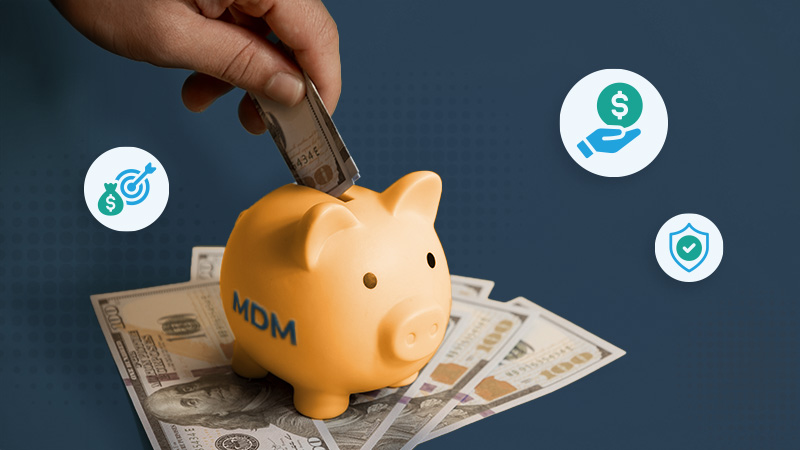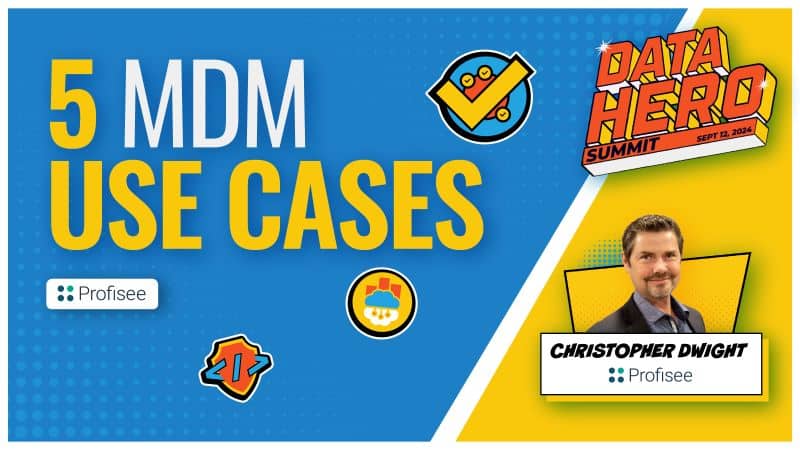As a former Gartner analyst, having the opportunity to reunite with my old colleagues in an exciting environment of 4000+ other data and analytics professionals is becoming a bit of an annual highlight for me.
The content is well presented, usually provocative and always insightful. And the best part is, the new friendships with professionals who live and breathe in the world of data make the annual trip to Orlando, Florida, well worth the price of admission.
That being said, here are my top five takeaways from this year’s Data & Analytics Summit — which thanks to the global pandemic, is happening for the second time in the last seven months as opposed to its usual annual cadence.

Profisee’s Malcolm Hawker (right) presenting at the summit with Nestlé Purina’s VP of Data Science, Brian Zenk (right), on business value and innovation.
1. The Conference Keynote Time Machine
As always, the opening keynote was a highly polished and exciting affair delivered to a room packed with 4000+ data professionals. As exciting as the opening keynote was, I was having some serious déjà vu, as I was sure I had already heard most of the keynote messages before — and that’s because I have.
Looking back over the last decade of Gartner Business Intelligence/Data and Analytics conferences, the key themes of ignoring shiny new things, focusing on business value and the importance of team development and leadership are recurring — and in the case of yet another new business value framework — the speakers acknowledged their repetition.
To be fair, when it comes to running a business, many of the key drivers of success don’t often change. However, the core messages of the keynote could have been delivered by these exact presenters 10 years ago and would have been just as relevant.
Beyond some of the glaring repetition of the keynote content from past events, I feel the presenters missed a fantastic opportunity to integrate another conference theme into their address: sustainability.
As a keynote theme, “lead for purpose” would seem a perfect opportunity to talk about how data can be used to support deeper social or environmental issues. But instead, the idea of “purpose” was linked directly to the (not so) new business value framework.
In other words, insofar as the keynote was concerned, “purpose” and “profit” are essentially synonyms. On the bright side, the new value framework appears to have been largely recycled from previous similar value framework efforts – so at least it was created using sustainable practices.
2. The Glaring and Growing
Strategy-to-implementation gap
While I found it completely refreshing to hear multiple Gartner analysts acknowledge that data fabrics, data observability and other conceptual data management frameworks — including composability, more on that below — cannot actually be purchased from any single vendor, this does also pose a bit of a problem.
By Gartner’s data, we know many organizations face serious challenges when it comes to their overall data and analytics maturity. This means the complexity of these new frameworks — across people, processes and technologies — is well beyond the grasp of most companies.
So, while it may be helpful for data leaders to understand where the market is heading to inform their longer-term data strategies, the fact is, most CDOs can’t benefit from these new frameworks — at least not in their current state.
Put another way, there is a glaring and growing gap between the strategic insights provided by Gartner at these events and the insights they provide on how to implement those insights. This gap between strategy and implementation is often highlighted by many analysts in their presentations. For example, from one of the many AI-centric presentations: “Operationalizing AI Remains the Top Challenge.”
Gartner is great at setting a “foundation” (Monday morning was full of content on foundational data management issues) and they are incredibly effective at helping to inform longer-term data and analytics strategies.
But if you’re a boots-on-the-ground data leader and you’re trying to understand all of the steps needed to get from where you are to where you want to be, you probably left the Orlando conference wanting more. Much more.
This insight gap between strategy and operations is largely a function of a shortage of hands-on data practitioners within the ranks of Gartner analysts — at least those analytics heavily engaged in these D&A summits. The higher-profile analysts at Gartner all tend to be career thought leaders, with few having spent any prolonged periods in the trenches leading any practical applications of the strategic frameworks and concepts they so artfully define.
So, if you’re a CDO scrambling to attract and retain top talent and you’re wondering how in the world you would ever execute on a data fabric, then you’re most certainly not alone.
3. The Generative AI Tortoise VS. Hare
A quote from the Monday keynote that resonated with me was: “Is ChatGPT interesting? Yes. Is it something you should be dropping a pile of money on right now? Probably not.” While this may be true for many companies, the description of ChatGPT and Hadoop as equals in the category of “shiny new things” seemed reckless to me.
For the record, in our world of data and analytics, an excessive focus on technology is always a bad thing.
However, I can’t recall many teenagers using Hadoop to complete their homework assignments. The mass adoption of Generative AI is based firmly on the transformative value it’s providing to over a hundred million active users — whereas Hadoop allowed a small group of data scientists to answer questions nobody in the business was asking. Comparing them makes no sense whatsoever.
So, while there were some great foundational presentations on AI and machine learning at the Gartner event — it’s starting to appear as if Gartner isn’t keeping sufficient pace with the market.
A presentation from Microsoft — which was entirely focused on how generative AI was being infused deeply into their Data and Analytics products — RIGHT NOW — truly solidified the disconnect between the “wait and see” espoused in the keynote and a company more focused on speed-to-market and integrating a technology that’s already shown a clear and meaningful value proposition.
DATA INSIGHTS,
DIRECT TO YOUR INBOX
4. That One Presentation That Made it
All Worthwhile
Even with the concerns raised above about Gartner recycling old content and moving too slowly, they remain consistent in having one or two incredibly forward-leaning and thought-provoking conference presentations that will likely make you want to keep coming back for more.
In the case of this event, it was a presentation from Mark Beyer on what he called “The Active Metadata Double Helix,” which is Mark’s attempt to describe what he views as a necessary change from “designing” data to “observing” data.
While on the surface this may seem like how we’ve always done things, we observe and then we design or model based on the observations. The addition of throwing new technologies into the mix is radically changing this paradigm.
A deeper discussion on how “activated” metadata will help to transform the business of data management is worthy of one — if not more — standalone blog posts. But to make a long story very short, advances in AI and graphs will help to enable data to classify its use and governance.
Rather than having humans define and manage the “rules” of data, over time data itself will define and manage its governance and management. This includes everything from data quality rules to data integration patterns, but it also extends into operational uses of data in business applications and workflows.
So, when Mark talks about “observing” data, it’s not humans doing all the observations, it’s mostly AI-powered knowledge graphs. The scale and automation these technologies will enable in the management of enterprise data will be truly game-changing.
This theme of using advanced technologies to enable a slow transition away from rule- or schema-defined data management to more metadata- and concept/context-defined data management was repeated in other presentations — including sessions about natural language processing, applied data observability and of course, the data fabric.
In the past, Gartner would have described this broader trend as “augmented data management,” but as of this conference, this new discipline or approach to data management no longer appears to have its own name. Perhaps this is a conscious decision, but I suspect it’s not.
5. Gartner is Still the Gold Standard for Conferences (Despite Hiccups)
Gartner knows how to run big industry conferences well. By comparison to other big conferences in Las Vegas where you’re often a two-mile walk between your hotel room and the conference hall, the logistics of the Disney resort are easy to navigate and attendee friendly.
There are plenty of options for sneaking away to power up a device or find a quiet spot, with several food and drink options that don’t require you to run a vendor gauntlet every time you feel thirsty. The quality of food remains very high — and if you ask me — surprisingly high given the number of mouths to feed.
The only real hiccup here was some unseasonably cool temperatures on Monday and Tuesday morning that resulted in the military-style mess hall tent experiencing temperatures hovering in the upper 40s and low 50s.
This caused what would have otherwise been a positive breakfast experience into the conference equivalent of a polar bear swim. The Gartner conference mobile app is solid and easy to use but has a notable gap in terms of enabling any sort of community/peer interactions or feedback during sessions.
Bonus Round: Recession? What Recession?
We may be living in highly uncertain times and the global and national economic situations remain highly chaotic, but if we are on the edge of any sort of global recession, you wouldn’t know it from the attendance or sentiment of the attendees.
Over three days, I had well over a hundred conversations with data leaders at our exhibit hall booth — and over breakfast, lunches and dinners where I can’t recall a single instance where anyone expressed concerns about an economic slowdown.
On the contrary, companies remain focused on foundational data-centric initiatives, many of which were initiated from 2020-2022. I heard about multiple situations where companies had prioritized master data and data governance initiatives over other priorities due to the acknowledgment that trustworthy and actionable data is key to all downstream efforts, be they operational or transformational in focus.
Notable Additions & Omissions
Addition – ESG/Sustainability
In 2022, Environmental, Social, and Governance (ESG) initiatives took a short hiatus thanks to COVID and war in Europe, but this week in Orlando it made a return. I predict that in 2024, more focus will be put on the elimination of “dark data” and other D&A drivers of excess data center consumption — which as an industry — contribute more greenhouse gases than the airline industry.
Omission – Composable D&A
Over the last two years, Gartner has been pounding the “composability” drum loud and hard at D&A events, in simpatico with a similar drumbeat coming out of the Gartner IT Symposium. However, that drumbeat was barely a flutter at this event, which generally means that — thanks to a lack of market adoption — Gartner is going to scale back the hype machine and let this previous “top trend” fade into oblivion.
Omission – Data as a Product
While there was some mention of this within conference presentations, there’s a glaring disconnect between the buzz around data products/data as a product on LinkedIn — and other social channels — and the degree of Gartner coverage at this event. I think this is largely a function of the strong association between data products and the data mesh, which Gartner avoids promoting thanks to the misguided perception that many see it as a competitor to the data fabric.
Omission – Augmented Data Management
For the better part of two years, Gartner was referring to the application of new technologies — such as graph and AI — to traditional data management as “augmented data management.” However, that label appears to have fallen out of favor — likely because most of the presentations that discussed it heavily leaned into data automation, not just augmentation. As I noted above, Gartner would be well served to come up with a new name here to describe this world of active metadata-infused data management. If the data fabric is the architecture, what’s the discipline called?
Malcolm Hawker
Head of Data Strategy @ Profisee

Malcolm Hawker
Malcolm Hawker is a former Gartner analyst and the Chief Data Officer at Profisee. Follow him on LinkedIn.












